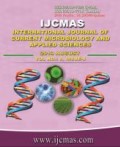


 National Academy of Agricultural Sciences (NAAS)
National Academy of Agricultural Sciences (NAAS)

|
PRINT ISSN : 2319-7692
Online ISSN : 2319-7706 Issues : 12 per year Publisher : Excellent Publishers Email : editorijcmas@gmail.com / submit@ijcmas.com Editor-in-chief: Dr.M.Prakash Index Copernicus ICV 2018: 95.39 NAAS RATING 2020: 5.38 |
For dietary status, growth, development and health, optimal feeding procedures are needed for infants and young children. In order to meet the difference in dietary demands transition foods need to be included in the diet. Diet diversity refers to all food groups being included in the diet. To assess food intake, a food intake questionnaire and a dietary recall method lasting 24 hours were used. Using the seven food groups, diet variety was calculated. ANOVA was used to compare means. Sixty infants and young children have been engaged in this studies. As household revenue rises, DDS has been discovered to be enhanced and is favorably associated with infant nutrition status. As DDS increased, with the exception of starch, the percentage of consumption in most food groups enhanced as everyone consumes starch from DDS 3. Milk and milk products among infants and young children with the greatest DDS were the most prevalent kinds of meal. At least 5 food groups are not received by 50 percent of children in their regular diet. If not, the macro and micro nutrients will certainly be in deficiencies that will affect the metabolic procedures that adversely affect the growth and development of children.
 |
 |
 |
 |
 |